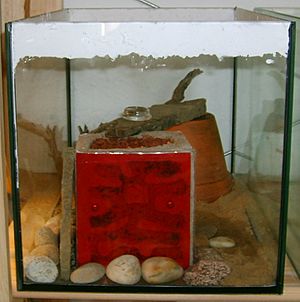Formicarium facts for kids
An ant farm (also called a formicarium) is like a special home for ants. It's built so people can watch how ant colonies live and how ants behave. People who study ants are called myrmecologists.
Contents
Building Materials for Ant Farms
Today, most ant farms you can buy are made from clear plastic (acrylic) or are created using a 3D printer. These newer types are much better than older "sandwich" style ant farms. They prevent tunnels from collapsing. Also, they are designed to keep queen ants with their workers. Older "Milton" type nests were only for worker ants.
A "sandwich" ant farm usually has two clear panels, like glass or plastic. These panels are placed close together. The space between them is filled with materials like soil, sand, or sawdust. This thin design lets you see the tunnels and rooms the ants dig. You can watch their behavior easily.
Some ant farms use a special gel. This gel acts as both the material the ants dig in and part of their food. However, these gel farms are not always good for ants in the long run. They might not give ants enough space or the right food. Sometimes, the gel can even be harmful to the ants. Most gels are blue and contain mostly sugar or agar.
Other types of ant farms are made from plaster or a material called autoclaved aerated concrete (AAC). You can make plaster nests by shaping tunnels and rooms with clay on a glass sheet. Then, plaster is poured over the clay. Once the plaster dries, the clay is removed. The plaster structure becomes a home for the ants. It's very easy to see the ants in these types of farms.
Some ant farms don't use any filling material at all. The ants might live in moist test tubes or other small containers inside a larger box. This also makes it easier to see the ants.
Keeping Ants Inside
Keeping ants inside their farm can be tricky! Ant farms can be designed to be open at the top. This means they don't need high walls or a lid. Instead, they use special barriers to keep the ants from escaping.
People use different things to stop ants from getting out. These include special oils, petroleum jelly, or a liquid called PTFE. These are put on the sides of the ant farm. Most ant species cannot walk on these slippery or sticky surfaces. But some clever ants might build bridges with dirt to get across. Some individual ants can even walk on these surfaces without trouble! So, ant farm owners often use two or more ways to prevent escapes.
Another common trick is to place the whole ant farm in a shallow dish of water. This creates a "moat" around the farm. Ants usually cannot cross water.
Some people who keep ants start by putting their colony in a "test tube outworld." This is a test tube connected to a small foraging area. It keeps the colony safe and comfortable while giving them a space to explore and find food.
Rules for Keeping Ants
There are some rules about keeping ants, especially queen ants.
In the United States, it's usually against the law to send live queen ants across different states without a special permit. Because of this, most ant farms sold in the US do not come with a queen ant. Professional ant shops can only send ants within the state where they are located.
In the European Union, some types of ants that live there naturally are protected. This means it's against the law to own, keep, buy, or sell these specific ants. It's also illegal to damage their nests. However, there are no laws about owning, keeping, buying, or selling tropical ants (ants from warmer climates). Most ant farms are made to house queen ants. Many professional ant shops in the EU sell colonies that include a queen.
Images for kids




